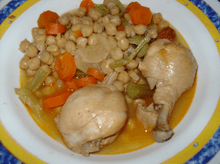Cocido

Cocido (Peninsular Spanish: [koˈθiðo] or Latin American Spanish: [koˈsiðo]) is a traditional Spanish stew. In Spanish, cocido is the past participle of the verb cocer (to cook), so cocido literally means "cooked [thing]." Various meats (pork, beef, chicken, mutton), embutidos, vegetables (cabbage, turnips, parsnips, potatoes, carrots), chickpeas (garbanzos), etc. are simmered in a pot, and sometimes other ingredients are added at serving time (such as eggs). Due to the wide regional diversity of the dish, the word cocido is typically followed by the place of origin (e.g. madrileño, maragato, lebaniego, gallego).
Characteristics
Cocido makes for a complete meal as it contains all the necessary components of a nutritious diet; in times past, it was a popular dish among laborers whose jobs involved much physical exertion. It was eaten primarily during the winter, helping people who lived in homes with inadequate heating maintain their body heat, so the vegetables used in cocido are typically winter vegetables like turnips, carrots, and cabbage. However, as vegetables are now available year-round, other vegetables may be substituted.
One commonality among all the regional variants is that the cocido is served in multiple courses in the same meal. The first course is usually a soup, followed by a second course of the beans and potatoes used in the soup, with the meat and vegetables from the soup as the third course. Each course is known as a vuelco (overturn), because the pot is turned over every time to empty out the ingredients. Recently, it has become popular in some areas to end with a plate of huevos estrellados.
Some ancient recipes (generally from convents) call for cocidos of up to fourteen courses, using an elaborate selection of ingredients.
Although the cocido madrileño is most famous, many other types exist, such as cocido lebaniego and cocido montañés.
During the 19th century, cocido was a common dish for servants in the homes of the wealthy. Often, too much would be made, and the excess would be given to the poor. Alternatively, the leftovers were tossed with eggs to be served for dinner or the next day, giving rise to the dish ropa vieja as well as arroz al horno and arroz con costra in Valencian cuisine.